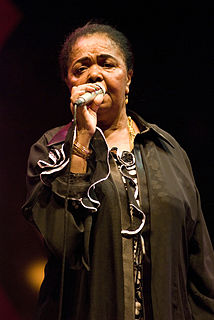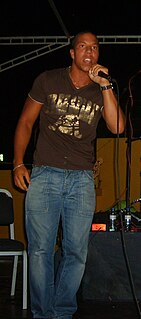
São Vicente is one of the Barlavento Islands, the northern group within the Cape Verde archipelago in the Atlantic Ocean, off the West African coast. It is located between the islands of Santo Antão and Santa Luzia, with the Canal de São Vicente separating it from Santo Antão.

Cape Verde is known internationally for morna, a form of folk music usually sung in the Cape Verdean Creole, accompanied by clarinet, violin, guitar and cavaquinho. Funaná, Coladeira, Batuque and Cabo love are other musical forms.
The morna is a music and dance genre from Cape Verde.
Manuel d' Novas was a Cape Verdean poet and composer.
The coladeira is a music genre from the Cape Verde islands in the central Atlantic Ocean.
Maria de Barros is a singer most associated with Cape Verde, the land of her parents. Growing up in Nouakchott, Mauritania, she moved to the United States at the age of 11, living in Providence, Rhode Island in her youth with her four siblings, and connecting more closely with her heritage in the local Cape Verdean community. She is married to, Mel Wilson Jr., a bassist with Toots and the Maytals.

Cesária ÉvoraGCIH, more commonly known as Cize, was a Cape Verdean singer-songwriter. She received a Grammy Award in 2004 for her album Voz d'Amor. Nicknamed the "Barefoot Diva" for performing without shoes, she was known as the "Queen of Morna".
Adriano Gonçalves, known by his stage name Bana and called the "King of Morna", was a Cape Verdean singer and performer of the morna style, the plaintive, melodic lament which is a staple musical style of the country.
Vasco Martins is a Cape Verdean musician and composer. Born in Queluz, Portugal, in 1956, he lives now in Calhau, Cape Verde.
Hernani Almeida is a Cape Verdean musician. In 1994 he formed his first rock band named What and has recorded and produced many albums. he was named Best Guitarist (2005) and Best Artist (2006) of the nation prize "Nos Musica" given to recognize Capeverdean artists.

The history of the cinema of Cape Verde dates back to the arrival of filmmakers in the early twentieth century. The first picture house was established in Mindelo around 1922, called Eden Park.
Francisco Xavier da Cruz, also known as B. Leza or Beleza was a Cape Verdean writer, composer and a singer.

Os Tubarões was a Cape Verdean traditional music band who, along with Bulimundo, Finaçon and Simentera, were among the most famous music bands in Cape Verde. The band name is Portuguese for "the sharks" which are common in the waters surrounding the archipelago.

The Literature of Cape Verde is among the most important in West Africa, it is the second richest in West Africa after Mali and modern day Mauritania. It is also the richest in the Lusophone portion of Africa. Most works are written in Portuguese, but there are also works in Capeveredean Creole, French and notably English.
Eddy Moreno born Adolfo de Jon Xalino (1915–1983) was a famous Cape Verdean singer. He belonged to the Xalino family of singers. His greatest singles included "Arriola" and "Grandeza", both appeared in the album Nos Festa in 1981.

Djô d'Eloy born Adolfo de Jon Xalino was a Cape Verdean singer, composer and guitarist. He belonged to the Xalino family of singers. His greatest singles included "Arriola" and "Grandeza", both appeared in the album Nos Festa in 1981. he was of the Xalino family. His most famous singles were "Reanima" and "Celina". Alongside Bana, he was the founder of the nation's first music festival, the Baía das Gatas Music Festival.
Nos Festa is an album recorded by Eddy Moreno. The album was released in 1981. It features the singles "Arriola" and "Grandeza". "Grandeza" was recorded by his nephew Val Xalino.

Roberto Xalino is a Cape Verdean singer, rapper and producer who currently resides in Gothenburg, Sweden. He is the son of the Capeverdean singer and producer Val Xalino.
The Culture of the Island of São Vicente, Cape Verde is the second richest in the nation, with a range of customs and practices common in the islands,
Criod de São Cente is a 2011 album by Val and Roberto Xalino. The songs were written by Val Xalino's son Roberto. The album includes the new single "Praía de Baia", one of Cape Verde's greatest ballads, released on Val Xalino's first album Dança Dança T' Manchê in 1987. Some singles features both Val and Roberto Xalino. The album also features music by Val and Roberto Xalino, Djo d'Eloy, Manuel de Novas and Luis Silva. Four singles from the record were nominated in the 2011 Cabo Verde Music Awards








